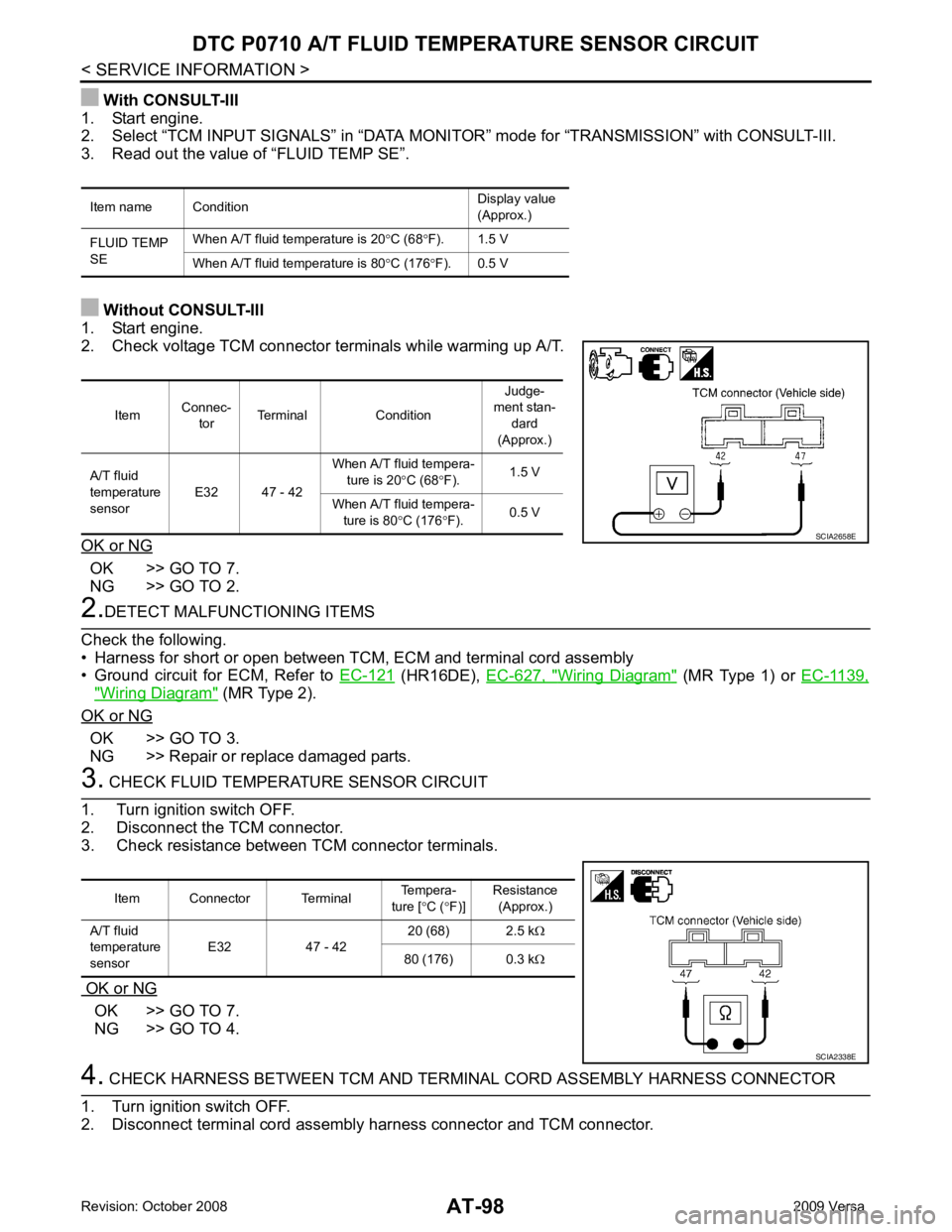sensor NISSAN LATIO 2009 Service Owner's Manual
[x] Cancel search | Manufacturer: NISSAN, Model Year: 2009, Model line: LATIO, Model: NISSAN LATIO 2009Pages: 4331, PDF Size: 58.04 MB
Page 77 of 4331

,
AT-187 ON vehicle
1. A/T fluid level
AT-17 2. Line pressure test
AT-51 3. Control valve assembly
AT-221 OFF vehicle
4. Forward clutch
AT-306 5. Oil pump
AT-277 6. Torque converter
AT-256Almost no shock or
clutches slipping in
change from D 1 to D 2
. ON vehicle1. A/T fluid level
AT-17 2. Accelerator pedal position sensor
EC-412
(HR16DE), EC- 959 (MR Type 1)
or EC-1481 (MR
Type 2)
3. Line pressure test AT-51 4. Accumulator servo release
AT-221 5. Control valve assembly
AT-221 OFF vehicle 6. Brake band
AT-330Almost no shock or
slipping in changing
from D 2 to D 3 . ON vehicle 1. A/T fluid level
AT-17 2. Accelerator pedal position sensor
EC-412
(HR16DE), EC- 959 (MR Type 1)
or EC-1481 (MR
Type 2)
3. Line pressure test AT-51 4. Control valve assembly
AT-221 OFF vehicle
5. High clutch
AT-301 6. Forward clutch
AT-306Almost no shock or
slipping in changing
from D 3 to D 4 . ON vehicle 1. A/T fluid level
AT-17 2. Accelerator pedal position sensor
EC-412
(HR16DE), EC- 959 (MR Type 1)
or EC-1481 (MR
Type 2)
3. Line pressure test AT-51 4. Control valve assembly
AT-221 OFF vehicle 5. Brake band
AT-330Races extremely fast
or slips in changing
from D 4 to D 3 when
depressing accelera-
tor pedal. ON vehicle1. A/T fluid level
AT-17 2. Accelerator pedal position sensor
EC-412
(HR16DE), EC- 959 (MR Type 1)
or EC-1481 (MR
Type 2)
3. Line pressure test AT-51 4. Line pressure solenoid valve
AT-134 5. Shift solenoid valve A
AT-139 6. Control valve assembly
AT-221 OFF vehicle
7. Brake band
AT-330 8. Forward clutch
AT-306Races extremel y
ON hi l 2. Accelerator pedal position sensor
EC-412
(HR16DE), EC- 959 (MR Type 1)
or EC-1481 (MR
Type 2)
Items Symptom Condition Diagnostic item Reference page
Page 78 of 4331

AT
N
O P
Slips/Will Not Engage
Races extremely fast
or slips in changing
from D 3 to D 2 when
depressing accelera-
tor pedal. ON vehicle1. A/T fluid level
AT-17 2. Accelerator pedal position sensor
EC-412
(HR16DE), EC- 959 (MR Type 1)
or EC-1481 (MR
Type 2)
3. Line pressure test AT-51 4. Line pressure solenoid valve
AT-134 5. Shift solenoid valve B
AT-144 6. Control valve assembly
AT-221 OFF vehicle
7. Brake band
AT-330 8. High clutch
AT-301Races extremely fast
or slips in changing
from D 4 or D 3 to D 1
when depressing ac-
celerator pedal. ON vehicle1. A/T fluid level
AT-17 2. Accelerator pedal position sensor
EC-412
(HR16DE), EC- 959 (MR Type 1)
or EC-1481 (MR
Type 2)
3. Line pressure test AT-51 4. Line pressure solenoid valve
AT-134 5. Shift solenoid valve A
AT-139 6. Shift solenoid valve B
AT-144 7. Control valve assembly
AT-221 OFF vehicle
8. Forward clutch
AT-306 9. Forward one-way clutch
AT-317 10. Low one-way clutch
AT-256Vehicle will not run in
any position. ON vehicle
1. A/T fluid level
AT-17 2. Control cable adjustment
AT-216 3. Line pressure test
AT-51 4. Line pressure solenoid valve
AT-134 OFF vehicle
5. Oil pump
AT-277 6. High clutch
AT-301 7. Brake band
AT-330 8. Low & reverse brake
AT-313 9. Torque converter
AT-256 10. Parking components
AT-236Items Symptom Condition Diagnostic item Reference page
Page 79 of 4331

ON vehicle
1. Ignition switch and starter
PG-3 ,
SC-9 2. Control cable adjustment
AT-216 3. PNP switch adjustment
AT-224Engine starts in posi-
tions other than “P”
and “N”. ON vehicle
1. Control cable adjustment
AT-216 2. PNP switch adjustment
AT-224Transaxle noise in“ P”
and “N” positions. ON vehicle1. A/T fluid level
AT-17 2. Line pressure test
AT-51 3. Accelerator pedal position sensor
EC-412
(HR16DE), EC- 959 (MR Type 1)
or EC-1481 (MR
Type 2)
4. Vehicle speed sensor·A/T (Revolution sensor)
and vehicle speed sensor·MTR AT-101 ,
AT-154 OFF vehicle
5. Oil pump
AT-277 6. Torque converter
AT-256Items Symptom Condition Diagnostic item Reference page
Page 81 of 4331

2. PNP switch adjustment
AT-224 3. Overdrive control switch
AT-172 4. Accelerator pedal position sensor
EC-412
(HR16DE), EC- 959 (MR Type 1)
or EC-1481 (MR
Type 2)
5. Vehicle speed sensor·A/T (Revolution sensor)
and vehicle speed sensor·MTR AT-101 ,
AT-154 6. Shift solenoid valve A
AT-139 7. Shift solenoid valve B
AT-144 8. Control valve assembly
AT-221 OFF vehicle
9. Reverse clutch
AT-296 10. High clutch
AT-301 11. Brake band
AT-330 12. Low & reverse brake
AT-313 13. Oil pump
AT-277 14. Torque converter
AT-256Transaxle noise in
“D”, “2”, “1” and “R”
positions. ON vehicle 1. A/T fluid level
AT-17OFF vehicle 2. Torque converter
AT-256Engine brake does
not operate in “1” po-
sition. ON vehicle1. PNP switch adjustment
AT-224 2. Control cable adjustment
AT-216 3. Vehicle speed sensor·A/T (Revolution sensor)
and vehicle speed sensor·MTR AT-101 ,
AT-154 4. Control valve assembly
AT-221 5. Overrun clutch solenoid valve
AT-149 OFF vehicle
6. Overrun clutch
AT-306 7. Low & reverse brake
AT-313Transaxle overheats.
ON vehicle1. A/T fluid level
AT-17 2. Engine idling speed
EC-30
(HR16DE), EC- 570 (MR Type 1)
or EC-1082 (MR
Type 2)
3. Accelerator pedal position sensor EC-412
(HR16DE), EC- 959 (MR Type 1)
or EC-1481 (MR
Type 2)
4. Line pressure test AT-51 5. Line pressure solenoid valve
AT-134 6. Control valve assembly
AT-221 OFF vehicle
7. Oil pump
AT-277 8. Reverse clutch
AT-296 9. High clutch
AT-301 10. Brake band
AT-330 11. Forward clutch
AT-306 12. Overrun clutch
AT-306Items Symptom Condition Diagnostic item Reference page
Page 83 of 4331

.)
Battery voltage
When overrun clutch solenoid valve
does not operate. (When overrun clutch
engaged. Refer to AT-22 .)
0 V
25 B Ground Always 0 V
26 Y PNP switch “1” position
and When setting selector lever to “1” posi-
tion. Battery voltage
When setting selector lever to other po-
sitions. 0 V
27 G PNP switch “2” position When setting selector lever to “2” posi-
tion. Battery voltage
When setting selector lever to other po-
sitions. 0 V
28 GR Power supply
(memory back-up) Always Battery voltage
29 V Revolution sensor When driving at 20 km/h (12 MPH) 150 Hz
30 *1
BR CONSULT- III (RX) — —
31 *1
Y CONSULT- III (TX) — —
34 LG PNP switch “D” position
and When setting selector lever to “D” posi-
tion. Battery voltage
When setting selector lever to other po-
sitions. 0 V
35 SB PNP switch “R” position When setting selector lever to “R” posi-
tion. Battery voltage
When setting selector lever to other po-
sitions. 0 V
36 R PNP switch “N” or “P”
position When setting selector
lever to “N” or “P”
position. Battery voltage
When setting selector lever to other po-
sitions. 0 V
38 G Turbine revolution sen-
sor (power train revolu-
tion sensor) When driving at 20 km/h (12 MPH) 360 Hz
Terminal
Wire
color Item Condition Judgement stan-
dard (Approx.)
Page 84 of 4331

AT
N
O P
*1
: These terminals are connected to the data link connector.
*2 : These terminals are connected to the ECM.
CONSULT-III Function (TRANSMISSION) INFOID:0000000004305330
CONSULT-III can display each diagnostic item using the diagnostic test models shown following.
FUNCTION
CONSULT-III REFERENCE VALUE NOTICE:
1. The CONSULT-III electrically displays shift timi ng and lock-up timing (that is, operation timing of each
solenoid).
Check for time difference between actual shift timi ng and the CONSULT-III display. If the difference is
noticeable, mechanical parts (except solenoids, sens ors, etc.) may be malfunctioning. Check mechanical
parts using applicable diagnostic procedures.
2. Shift schedule (which implies gear position) display ed on CONSULT-III and that indicated in Service Man-
ual may differ slightly. This occurs because of the following reasons:
- Actual shift schedule has more or less tolerance or allowance,
- Shift schedule indicated in Service Manual re fers to the point where shifts start, and
- Gear position displayed on CONSULT-III indicates the point where shifts are completed.
3. Shift solenoid valve “A” or “B” is displayed on CONSUL T-III at the start of shifting. Gear position is dis-
played upon completion of shifting (which is computed by TCM).
39
*2
L Engine speed signal
and Refer to
EC-461 (HR16DE),
EC-597 (MR Type 1) or
EC- 1109 (MR Type 2).
40 O Vehicle speed sensor When driving vehicle at 2 to 3 km/h (1 to
2 MPH) for 1 m (3 ft) or more. Voltage varies
between less
than 0 V and
more than 4.5 V
42 B Sensor ground Always 0 V
47 BR A/T fluid temperature
sensor and When A/T fluid temperature is 20
°C
(68 °F). 1.5 V
When A/T fluid temperature is 80 °C
(176 °F). 0.5 V
48 B Ground Always 0 V
Terminal
Wire
color Item Condition Judgement stan-
dard (Approx.) Diagnostic test mode Function
Work Support This mode enables a technician to adjust some devices faster and more accuratelyI.
Self Diagnostic Results Retrieve DTC from ECU and display diagnostic items.
Data Monitor Monitor the input/output signal of the control unit in real time.
CAN Diagnosis Support Monitor It monitors the status of CAN communication.
Function Test This mode can show results of self-diagnosis of ECU with either “OK” or “NG”. For engine, more
practical tests regarding sensors/switches and/or actuators are available.
DTC & SRT confirmation The status of system monitoring tests and the self-diagnosis status/result can be confirmed.
ECU Identification Display the ECU identification number (part number etc.) of the selected system. Item name Condition Display value (Approx.)
VHCL/S SE-A/T During driving Approximately matches the speedometer
reading.
VHCL/S SE-MTR
THROTTLE POSI Released accelerator pedal. 0.0/8
Fully depressed accelerator pedal. 8.0/8
Page 86 of 4331

AT
N
O P
SELF-DIAGNOSTIC RESULT MODE
Display Items List
*1: Refer to AT-41, " Malfunction Indicator Lamp (MIL) " .
LINE PRES DTY Line pressure low
⇔ Line pressure high 0 % ⇔ 94 %
TCC S/V DUTY Lock-up OFF ⇔ Lock-up ON 4 % ⇔ 94 %
Item name Condition Display value (Approx.) Items (CONSULT-III
screen terms) Malfunction is detected when... OBD-II (DTC)
Reference page
MIL indicator
lamp*1, “EN- GINE” with
CONSULT-III
or GST
CAN COMM CIRCUIT • When TCM is not transmitting or receiving CAN communication signal
for 2 seconds or more. U1000
AT-88PNP SW/CIRC
• TCM does not receive the correct voltage signal (based on the gear
position) from the switch. P0705
AT-91ATF TEMP SEN/CIRC • TCM receives an excessively low or high voltage from the sensor. P0710
AT-96VHCL SPEED SEN-A/T • TCM does no
t receive the proper voltage signal from the sensor. P0720 AT-101ENGINE SPEED SIG • TCM does not
receive the proper voltage signal from the ECM. P0725 AT-106A/T 1ST GR FNCTN
• A/T cannot be shifted to the 1st gear
position even if electrical circuit
is good. P0731
*2
AT-110 A/T 2ND GR FNCTN
• A/T cannot be shifted to the 2nd gear position even if electrical circuit
is good. P0732
*2
AT-113 A/T 3RD GR FNCTN
• A/T cannot be shifted to the 3rd gear position even if electrical circuit
is good. P0733
*2
AT-116 A/T 4TH GR FNCTN
• A/T cannot be shifted to the 4th gear position even if electrical circuit
is good. P0734
*2
AT-119 T/C CLUTCH SOL/V
• TCM detects an improper voltage drop when it tries to operate the so-
lenoid valve. P0740
AT-124A/T TCC S/V FNCTN • A/T cannot perform lock-up even if electrical circuit is good.
P0744*2
AT-129 LINE PRESSURE S/V
• TCM detects an improper voltage drop when it tries to operate the so-
lenoid valve. P0745
AT-134SHIFT SOLENOID/V A
• TCM detects an improper voltage drop when it tries to operate the so-
lenoid valve. P0750
AT-139SHIFT SOLENOID/V B
• TCM detects an improper voltage drop when it tries to operate the so-
lenoid valve. P0755
AT-144OVERRUN CLUTCH S/
V • TCM detects an improper voltage drop when it tries to operate the so-
lenoid valve. P1760
AT-149VHCL SPEED SEN-
MTR • TCM does not receive the proper voltage signal from the sensor. —
AT-154BATT/FLUID TEMP
SEN • TCM receives an excessively low or high voltage from the sensor. —
AT-157TURBINE SENSOR • TCM does not receive proper voltage signal from sensor. —
AT-163CONTROL UNIT (RAM) • TC
M memory (RAM) is malfunctioning. — AT-168CONTROL UNIT (ROM) • TCM memory
(ROM) is malfunctioning. — AT-168No failure
(NO SELF DIAGNOS-
TIC FAILURE INDICAT-
ED FURTHER
TESTING MAY BE RE-
QUIRED) • No failure has been detected. — —
Page 90 of 4331

AT
N
O P
OD OFF indicator lamp
All judgement flickers are the same.
All circuits that can be confirmed by self-diagnosis are OK. 1st judgement flicker is longer than others.
Revolution sensor circuit is short-circuited or disconnected.
⇒ Go to AT-101 .
2nd judgement flicker is longer than others.
Vehicle speed sensor circuit is short-circuited or disconnected.
⇒ Go to AT-154 .
4th judgement flicker is longer than others.
Shift solenoid valve A circuit is short-circuited or disconnected.
⇒ Go to AT-139 .
5th judgement flicker is longer than others.
Shift solenoid valve B circuit is short-circuited or disconnected.
⇒ Go to AT-144 .
6th judgement flicker is longer than others.
Overrun clutch solenoid valve circuit is short-circuited or discon-
nected.
⇒ Go to AT-149 .
Page 91 of 4331

.
8th judgement flicker is longer than others.
A/T fluid temperature sensor is disconnected or TCM power supply
circuit is damaged.
⇒ Go to AT-157 .
9th judgement flicker is longer than others.
Engine speed signal circuit is short-circuited or disconnected.
⇒ Go to AT-106 .
10th judgement flicker is longer than others.
Turbine revolution sensor (power train revolution sensor) circuit is
short-circuited or disconnected.
⇒ Go to AT-163 .
OD OFF indicator lamp
Page 103 of 4331

OK >> GO TO 7.
NG >> GO TO 2. (HR16DE),
EC-627, " Wiring Diagram " (MR Type 1) or
EC-1139," Wiring Diagram " (MR Type 2).
OK or NG OK >> GO TO 3.
NG >> Repair or replace damaged parts. OK >> GO TO 7.
NG >> GO TO 4. Item
Connec-
tor Terminal Condition Judge-
ment stan- dard
(Approx.)
A/T fluid
temperature
sensor E32 47 - 42 When A/T fluid tempera-
ture is 20 °C (68 °F). 1.5 V
When A/T fluid tempera- ture is 80 °C (176 °F). 0.5 V